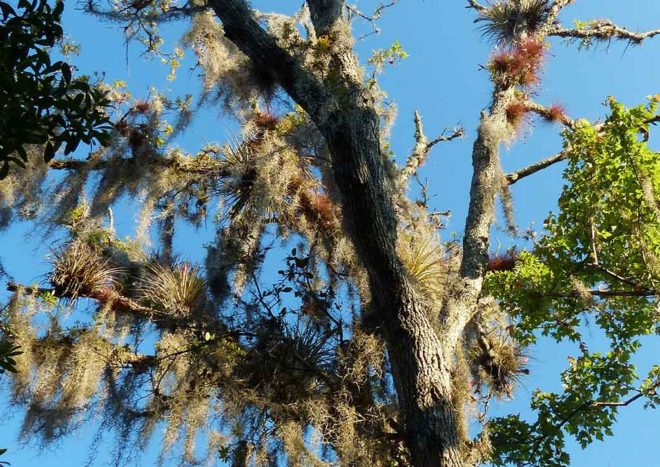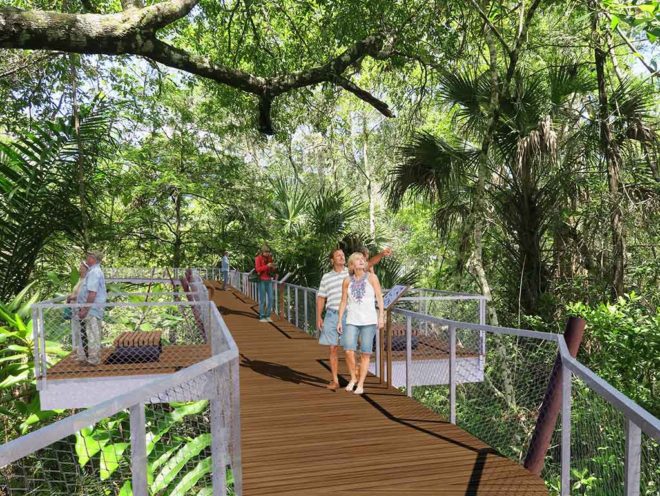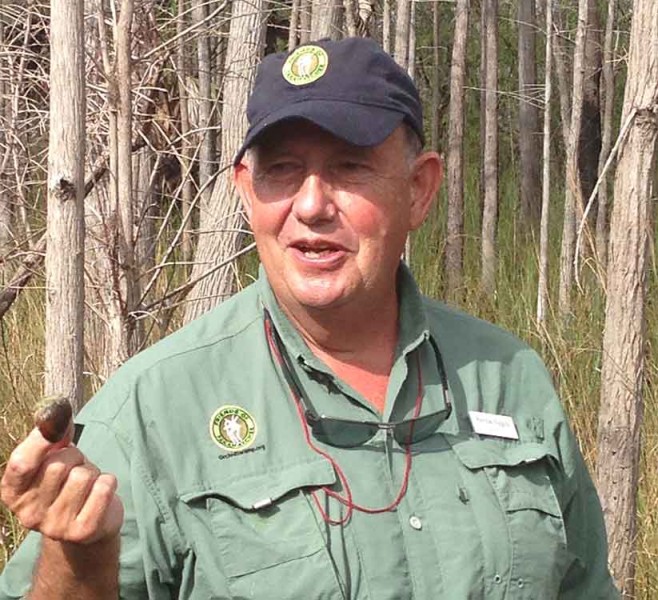by Patrick Higgins
Sloshing through the swamp, our view is primarily tree trunks and water. However for our recently arrived migrants from the Amazon, the swallow-tailed kite, it’s an entirely different view. As they swoop low over the swamp’s canopy to snatch an unsuspecting tree frog, they see an undulating carpet of almost endless green. Occasionally this verdant aerial landscape is punctuated by a splash of color. This will be the bloom of epiphytes.

Southern needle-leaf, cardinal airplants and Spanish-moss festooning an oak canopy. Photo by Patrick Higgins
Epiphytes are plants that grow harmlessly on other plants without drawing nourishment from them, using them merely for support. Ours fall into 5 main groups; bryophytes, lichens, ferns, bromeliads and orchids. The largest concentrations of epiphytes are found in tropical rainforests. Thinking about that environment, it’s easier to understand the evolutionary pressures to become an epiphyte.
Light and space on the forest floor are scarce. That same forest floor may become periodically flooded. So it’s natural that some species would migrate upwards towards brighter light, protection from flooding and from the foraging of animals. There also is greater air circulation for better seed and spore dispersal.
But as always in nature there is a trade-off. Perched in the canopy water is scarcer; removed from the ground, nutrients are harder to obtain. So these plants have had to evolve special adaptations to retain moisture and to capture nutrients. Some root systems have become diminished, functioning solely as anchors. In these plants nutrient absorption has been taken over by their leaves. While others, like our ghost orchid, have abandoned leaves altogether and evolved strap-like chlorophyllous roots in their place to both anchor them and produce food.
Other adaptations are micro seeds that are easily wafted by the slightest breeze or tufts of fine hairs to help transport seeds on the wind. However, the evolutionary arms race is two sided. Whilst Fakahatchee’s epiphytes seldom achieve enough mass to damage branches, many tropical trees like the gumbo limbo have evolved shedding bark to rid themselves of juvenile epiphytes and twining vines.
Our most obvious epiphytes are our bromeliads, those spiky growths in our trees that resemble the tops of their terrestrial cousin, the pineapple. They are almost exclusively tropical and a new world phenomenon. Of the 3,400 known species, just one has made it outside of our hemisphere. Here in the Fakahatchee near the northern limit of their range, our 16 native species qualify us as the U.S. bromeliad capital.
Bromeliad water and nutrient absorption have largely been taken over by their leaves and they can be categorized by how this absorption takes place. Spanish moss and ball moss are atmospherics or true ‘air plants’. Their leaves are typically silvery gray and coated with unique leaf scales called trichomes. Trichomes can absorb water – and the minerals dissolved in it – directly from the air when available, then clamp down to minimize moisture loss when it’s not. Their silvery surface also helps to reflect light, further reducing moisture loss.
The rest of our bromeliad gang are impounders. These have their leaves arranged in whorls to trap water in a central reservoir. This tank also collects litter falling from the forest canopy and drowned insects. The process of decay transforms the water into a broth from which the plant extracts valuable nutrients. These tanks also form miniature ecosystems in their own right where micro-organisms may live out their entire life cycles. In the tropics some may even become nurseries for tadpoles. It’s not uncommon to see birds drinking from them, who might then leave nutrient–rich droppings.
Most of our silvery-gray bromeliads have another important adaption to living in Florida’s periodic drought conditions. They employ CAM photosynthesis rather than the more common C3 pathway. In CAM the leaf stomata only open at night to take up CO2 which is then stored for use in the daytime. This avoids their pores having to open in sunlight when water loss would be higher.
Half of the Fakahatchee’s native orchid species are epiphytic. All have precise fungal associations necessary for nutrient uptake, many have pseudobulbs – swollen stem bases that serve as water storage organs – and three are leafless. They are also all of tropical origin, with most in common with Cuba. This connection is not surprising as the Park is less than 200 miles from Havana – the direction of our prevailing winds. But there’s more to it than that.
Our sloughs, especially the central slough, continuously radiate humidity even in the driest years from an accumulation of peat. The moisture is trapped by the forest canopy creating a microclimate. In the summer it’s always just a little bit cooler and in the winter just a little bit warmer. This means that many parts of the Strand never freeze in the even the coldest years, allowing those minute, windborne orchid seeds blown up from the tropics to flourish.
Less spectacular are our bryophytes (mosses and liverworts). They are often represented by a fuzzy green layer on logs and branches, which if you examine closely appear as tiny forests. They have a lifestyle halfway between that of aquatic algae and ferns. They require moisture, but can dry out, go completely dormant, then spring back to life when moisture returns. Their ability to readily store and release water is an important ecosystem function. They can also help create a secondary ‘terra firma’ high up on horizontal branches by stabilizing detritus. This improves the habitat for other epiphytes.
Another epiphytic group is our lichens. They form those beautiful blotches of pink, orange, white and blue-gray on almost every trunk and limb, varying in texture from crust-like to scaly or even filamentous like old man’s beard. Lichens can be so numerous it’s hard to discern a tree trunk’s true color.
They are composite organisms: a fungus and an algae or cyanobacteria living together symbiotically. The fungus provides shelter and water absorbing services to the algae, which would otherwise be unable to survive, and the algae in turn produce sugars through photosynthesis.
It was often thought that lichens were more abundant in northern latitudes, but in 2009 a group of lichenologists conducted a 5-day survey in the Fakahatchee and recorded 432 species, putting paid to that theory!
Our epiphytic community wouldn’t be complete without mention of our half a dozen or so species of epiphytic ferns. Many of them utilize the organic material in the boots of Sabal palms like rabbit foot, hand, and shoestring ferns.
The most remarkable of all is our resurrection fern which favors rough-barked trees. Its leaves curl and turn brown when desiccated, then resurrect themselves after a good rainfall, quickly becoming a lush green – a throw-back to a bryophyte ancestor.
The canopy and all its plant diversity combine to sequester carbon, produce oxygen and support a complex web of life, from pollinators and millions of other insects, to spiders, mites, snails, tree frogs, snakes, lizards, birds, bats and squirrels. We don’t often get a close-up look, but this may all change.

Architect’s renderings of future Canopy walk in Phase II of Big Cypress Bend Boardwalk Expansion Project. Rendering by David Corban pllc
In partnership with the state, FOF has a major boardwalk improvement project underway at Big Cypress Bend. Phase 1 this year is a new parking area, a bridge over the canal, and low-level marsh boardwalk. Yet to be funded is Phase 2, that includes plans for an 1100 ft. long elevated canopy walk through the Strand. In a few years we may all be able to experience life in the high rise.
Patrick Higgins is a National Association of Interpretation Certified Interpreter, Vice-President of the Friends of Fakahatchee and Project Manager for the development of the Boardwalk Master Interpretive Plan.

